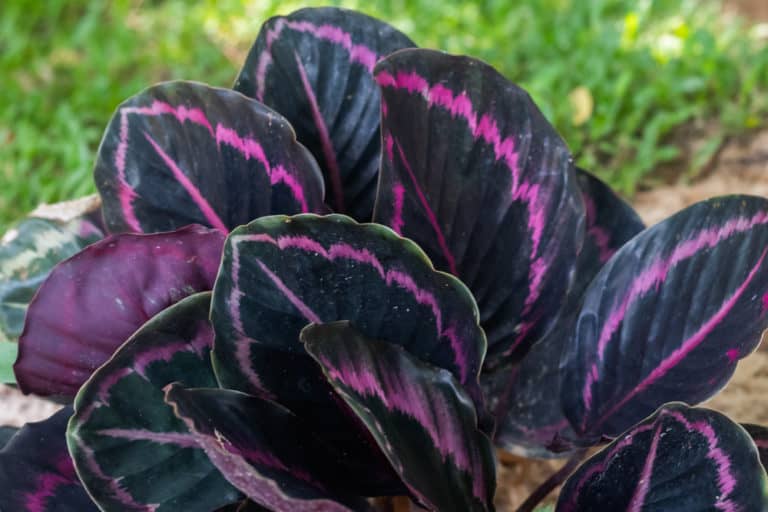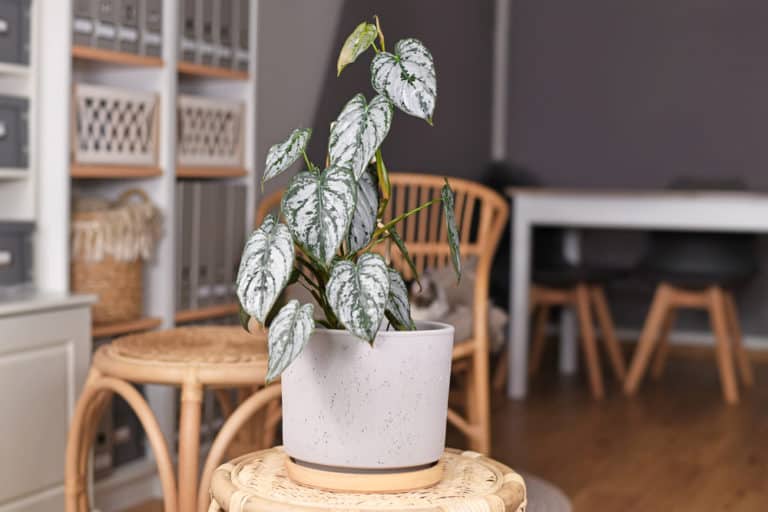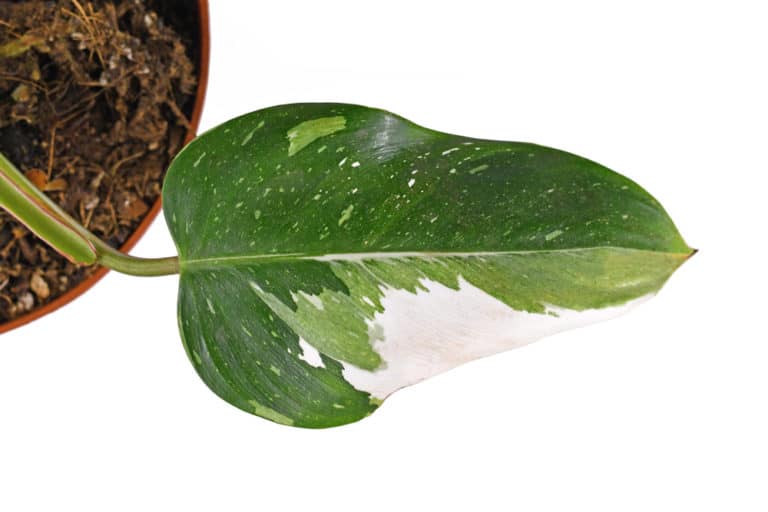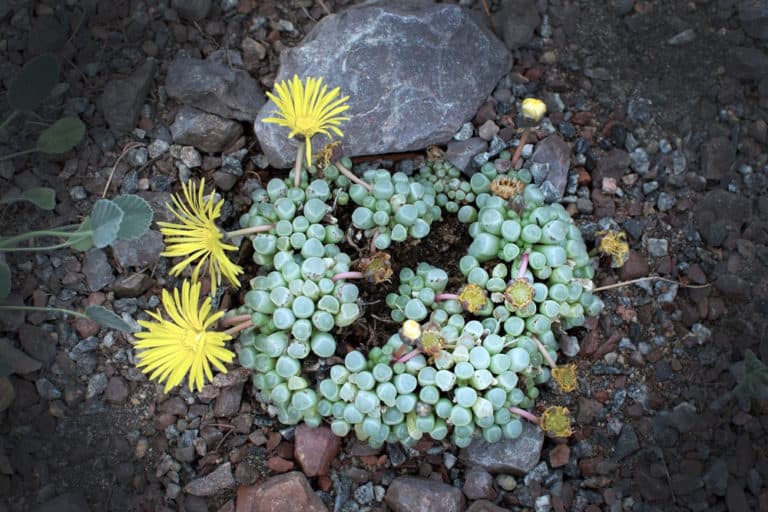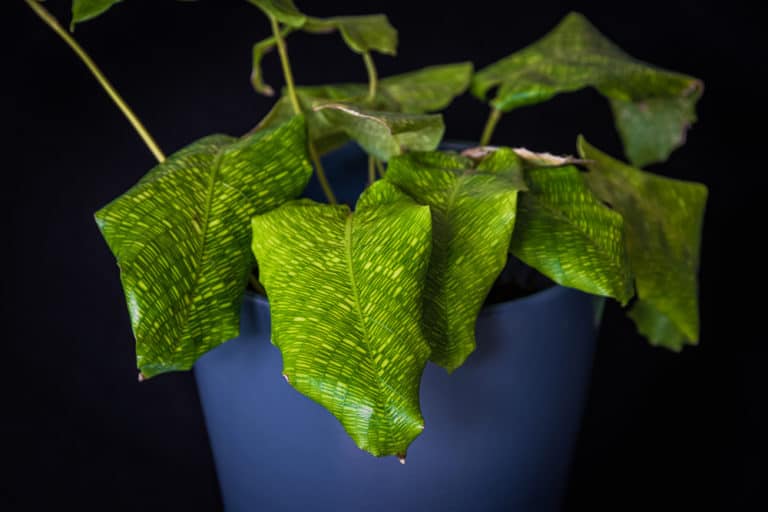Alocasia Baginda ‘Silver Dragon’ Care Guide (2024)
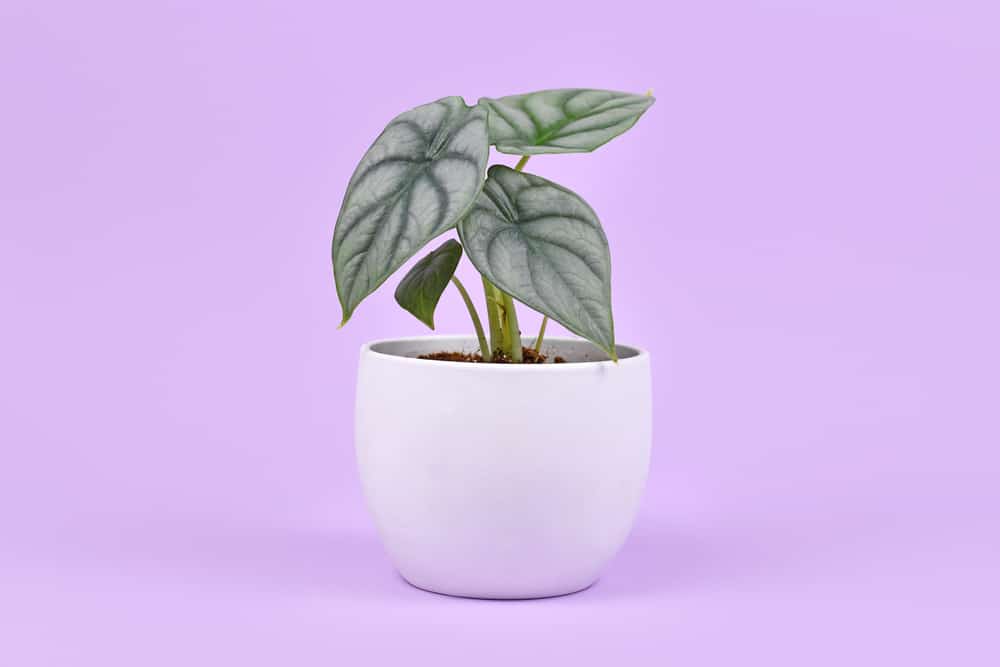
If you happen to stumble upon this plant at your local market, you’re certainly in luck! This is because Alocasia baginda silver dragon is hard to come by, hence, considered a rare specimen.
Its intricate leaves likened to that of a dragon scale are among its best features, it’s also why it was named Alocasia silver dragon.
| Scientific Name | Alocasia baginda |
| Common Name | Alocasia baginda silver dragon, Jewel Alocasias, Elephant Ear Silver |
| Light | Bright dappled light |
| Watering | 2-3 times a week |
| Temperature | 55°F– 80°F (13°C to 27°C) |
| Hardiness Zone | USDA hardiness zones 9-11 |
| Humidity | >70% |
| Soil Type | High in OM, quick-draining, loamy |
| Soil pH | pH 5.0 to 7.5 (acidic to neutral) |
| Fertilizing | N-fertilizer |
| Repotting | Every 2-3 years |
| Pruning | Occasionally; Beginning of the growing season |
| Propagation | Root Clump Division |
| Toxicity | Toxic to humans and pets |
| Mature Size | 24 to 36 inches as a houseplant |
| Bloom Time | Late spring; early summer |
What’s Unique About Alocasia Silver Dragon?
The Alocasia silver dragon plant is truly a remarkable species. The silvery textured leaves resemble dragon scales, a unique pattern that makes it a highly sought-after plant in the market.
Also belonging to the aroid family, Alocasia silver dragon plants are a part of the Jewel Alocasia series, but it can certainly stand on its own, due to its radiating color pattern that may be imagined to have come out straight from a fantasy world!
But don’t be fooled, as the silver dragon plant is native to Borneo and other subtropical parts of Asia and Eastern Australia. Due to massive domestication efforts, they have become widely distributed, but they may still not be that easy to find.
Alocasia Silver Dragon Care
For the Alocasia Silver Dragon plant Care, it’s important to note that the plant enjoys medium to bright light. It thrives well in temperatures between 55°F– 80°F (13°C to 27°C) and humidity of about 70%. A consistent watering cycle should also be observed as well as exposure to a medium-bright level of light. Below is a more in-depth guide to help you be equipped when it comes to silver dragon plant care.
Light
The Alocasia silver dragon light requirements are from medium to bright levels. Finding a strategic location where the plant receives adequate but indirect light is key to maintaining the plant’s vibrant foliage. It’s essential to avoid exposing the plant to a prolonged period of intense light as they are prone to scorching. Also, full sun exposure may cause irreversible damage to the foliage.
Pro tip: When grown inside, blushing Philodendron light needs may be attained by placing them near a west or east-facing window. This will help provide the right balance of light for your Alocasia silver dragon – preventing their direct exposure to high light intensity.
Watering
Summer through spring is also accompanied by extensive growth. Hence, a watering cycle of two to three times a week is recommended. The best way to check the watering needs of your Silver dragon plant is by sticking your finger directly to the soil. Nonetheless, the kind of planting medium you used may also affect the frequency of Alocasia silver dragon watering as does water retention.
If you have used more garden soil than your substrates, you may end up having heavy soil that is prone to waterlogging. Waterlogging is the ultimate plant killer, hence, you should water silver dragon with just the right amount. Do not allow the soil to become soggy as this may cause damage to the root system.
Temperature
The Alocasia silver dragon temperature range sits between 55°F– 80°F (13°C to 27°C). The plant may easily thrive at a typical temperature found in most indoor home setups. However, it is important to keep them away from drafty areas as these plants do not possess low-temperature tolerance, hence, they may be susceptible to freezing damage.
The ideal temperature for silver dragon Alocasia is warm but it may even withstand high temperatures of up to 95°F (32°C). For those living in areas of USDA hardiness zones 9-11, you can easily raise this gorgeous aroid without much of a fuss. These zones offer the optimal climate.
Humidity
Considering that the plant originates from a subtropical environment, you may expect that the Alocasia silver dragon humidity requirements should be at least 70% or higher. If you’re growing the plant inside, you should aim for a higher than normal humidity level as the silver dragon finds this more enjoyable – allowing it to grow robustly.
Pro tip: While the humidity level surrounding the plant rarely becomes an issue, you can still achieve the ideal humidity for silver dragon by investing in a humidifier or setting up a pebble tray. Do this by filling up a tray with pebbles and water, and then placing the plant on top of the tray. This will create a more humid atmosphere for your houseplants.
Soil
The Alocasia silver dragon soil should be well-draining but evenly moist. An equal proportion of garden soil, perlite, mulch, and peat moss should be enough to create the ideal soil for silver dragon. You may also opt to incorporate other amendments that can add more organic matter to your soil mix, such as coco coir, garden compost, and vermicast.
Furthermore, the ideal ph level for silver dragon is from slightly acidic to neutral, which is pH 5.0 to 7.5. To sum it up, aim for soil with good permeability, adequate aeration, and is rich in OM for added texture and nutrients.
Fertilizer
The Alocasia silver dragon fertilizer should be given twice a month, particularly during the growing season. Since it is a foliage plant, you may apply a fertilizer ratio that is higher in nitrogen, this will promote the luscious formation of the leaves and even faster growth.
Other than N fertilizer, you may also invest in a more natural plant feed such as bone meal, as this also proves to be efficient in mimicking the calcium-rich environment by which the plant ideally thrives. Avoid using a cheap fertilizer for silver dragon, as this can do more damage than good. Cheap fertilizers can drastically alter soil characteristics leading to nutrient imbalance and highly acidic/alkaline soil.
Potting & Repotting
The Alocasia silver dragon repotting is not a frequent activity since the plant is relatively small. Growing only at about 2 feet tall, the best way to determine whether the plant already needs repotting is by checking the base of the plant. When roots begin to protrude from the drainage holes, this calls for larger pot size.
When repotting silver dragon, be sure to prepare a fresh potting mix beforehand. Fill the new pot halfway with soil and clean the plant’s base by brushing off old substrates. Place it in the center of the pot and fill it with the rest of the remaining soil. With adequate lighting and water, the plant will bounce back in no time.
Pruning
The Alocasia silver dragon pruning is typically done when it is suffering from a disease or in need to get rid of spent leaves and flowers. Additionally, pruning is regarded as a good practice to revive the plant and promote new growth. However, the plant will do just fine without much pruning as it only ever grows to a manageable size.
Pro tip: When cutting silver dragon, you may start from the base of the plant where the older leaves are mainly found. Do not over-trim, use a sterile shear, and take only those that may be infected or are simply decaying.
Propagation
The Alocasia silver dragon propagation is usually done during mid-spring or early summer and the most common method is by root clump division and bulbils. To propagate silver dragon by clump division, you may initially remove the parent plant from its pot and carefully wash the soil around the roots.
Afterward, you may begin to separate the multiple clumps of roots either with your finger or a knife. Put each clump in separate containers and water as needed until the clumps have become well-established and have formed stronger roots. Bulbils, on the other hand, may also be used to multiply this tropical gem.
Also, make sure to check out our in-depth Alocasia stingray plant care guide.
Common Problems of Alocasia Silver Dragon
The most common Alocasia silver dragon problems often result from improper cultural management such as overwatering and underwatering. Hence, these problems with silver dragon may be easily prevented by observing proper growth requirements. However, other symptoms shown in the leaves may have also resulted from pathogenic infections or pest infestations.
Pests
The most common Alocasia silver dragon pests are scale bugs, thrips, aphids, and mites. However, most pests are not that threatening to this type of plant, as the silver dragon proves to be resilient to most feeding insects.
Pro tip: If you notice that your plant has wounds and is crawled upon by ants, the best way to repel insect pests is through the use of horticultural oil such as neem oil and citronella. It’s also a good habit to regularly wipe the leaves of your plant with rubbing alcohol or simply with clean water to remove debris and residues that may have been left behind by plant-sucking insects.
Diseases
The most prevalent Alocasia silver dragon diseases are wet brown spots on leaves, leaf edema, and sudden wilt. Waterlogging due to overwatering predisposes the plant root to rot. When the root system begins to rot, the transport of nutrients, oxygen, and other assimilates are disrupted, thus, causing damage to the plant by compromising overall physiological functioning.
Pruning proves to be efficient in getting rid of spent leaves and other decaying portions that may or may not have been caused by infection. Removing such parts enables the reallocation of the silver dragon plant’s energy to new growth, therefore, ensuring a fuller and healthier foliage formation.
Growing Problems
Growing problems with the Alocasia silver dragon are influenced by both abiotic and biotic factors around the plant. With proper cultural management, you can prevent a situation where you have to tend to a sick plant.
Other tips to help you grow your Alocasia silver dragon stress-free include 1) Growing them under bright dappled sunlight; 2) Avoiding overwatering which can lead to root rot; 3) Use of appropriate potting medium which is well-draining and high in OM content; 4) Use of natural means of pest control such as citronella and neem oil as these are more eco-friendly; and 5) Use of sterile equipment for plant maintenance to prevent the occurrence of fungal and bacterial infection.
Toxicity of Alocasia Silver Dragon
Most species of the Araceae family have some level of toxicity and the Silver dragon plant is no exception. This is due to the needle-like crystals that make up a compound called Calcium oxalate. Thus, silver dragon plants are toxic to both humans and animals.
Read on further to learn about the symptoms and measures should any part of the plant has accidentally been ingested.
For Humans
All parts of the Silver dragon plant are considered toxic to humans. This is because almost every segment of this specimen contains calcium oxalate crystals that if ingested (especially in large amounts) can cause skin irritation and disorders. Other symptoms that may occur include vomiting, diarrhea, skin and mouth blisters, nausea, difficulty breathing, and difficulty swallowing.
Small children are at great risk. So if you have toddlers around the house, it may be best to grow the silver dragon plant outside – far from playful and highly curious ‘spectators’. Should any of the above-mentioned symptoms occur, you should immediately seek medical attention or call your local poison hotline.
For Pets
Like children, pets are playful and certainly like to nibble on random stuff – and houseplants are an easy target. Sadly, the silver dragon is also considered toxic to both cats and dogs. If ingested, some of the symptoms that may occur are diarrhea, urine in blood and stool, pawing of the face, blisters in the mouth, and restlessness.
If you have a lot of furry friends at home, you need to find a spot that is out of their reach such as an elevated cabinet, windowsills, and counter table. But since cats are effortless climbers, you may consider growing your silver dragon plant outside and investing in more pet-friendly houseplants.
Alocasia Silver Dragon Appearance
The Alocasia silver dragon appearance becomes more interesting by the set of foliage that’s seemingly out of this world. It will magically draw you in as it’s certainly hard to ignore. The leaves are notable for the silvery scale-like pattern and arrow shape – making the plant a perfect specimen for either indoor or outdoor.
Foliage
Having no need for introduction, the foliage of Alocasia silver dragon is what makes it stand out among other species of the aroid family. As the name implies, each leaf of the Alocasia baginda is covered with glossy silvery markings that appear to be similar to that of a dragon’s scales.
Several reports indicate that under dappled light conditions, the glossy silvery patterns tend to spread along the leaves and the venations develop a deep green color. The shape of the leaves is similar to most of the aroid species but some have taken note of the spade-like and drastically pointy edge of the leaves, botanically termed as peltate.
Flowering
While the plant is mainly recognized for its majestic leaves, the occurrence of Alocasia silver dragon flowering is still an interesting sight to behold. Note, however, that they rarely form in cultivation and are not considered to be an essential feature of this foliage plant.
Blooming period would occasionally occur during spring and summer. In the wild, flowering may occur more frequently. Interestingly, the silver dragon plant flower comes in a piston-shaped flower enclosed in a pale green to white bract, a specialized leaf by which some floral axis arises. The bract and leaf whorls are oftentimes more attractive than the true flower.
Size and Growth
This tropical beauty appears to be compact as compared to other species that belong to the same genus. Hence, the size of Alocasia silver dragon only roughly goes up to about 1.6 feet or 0.5 meters tall.
Meanwhile, the leaves can expand from 15 cm to 20 cm in length and 5 to 8 cm in width. The juvenile stage of the plant is highly coveted as this can be used for terrariums, and in setting up dish gardens.
But when planted in the ground, the silver dragon plants will eventually grow taller and wider given the space surrounding them. The plant has a medium growth rate but may even grow faster as long the right nutrient and cultural management is provided.
Alocasia Silver Dragon Fragrance
Reports on Alocasia silver dragon fragrance vary. Some would say that the plant does not possess any specific type of scent other than an earthy, tropical note. Others indicate that the flower emits a citrusy smell, especially when in full bloom.
But whether the plant possesses a distinct fragrance or not, there are certain smells that may signal the presence of an impending disease.
For example, symptoms like leaf spots and necrosis have unpleasant odors which can be caused by bacterial infection. Bacterial leaf spots are quite common in Alocasia silver dragon. So make it a habit to regularly check on your plant as early detection results in faster treatment and recovery.
Suggested Uses for Alocasia Silver Dragon
Growing Alocasia silver dragon will certainly give your home a mystical touch. Yet other than its embellishing nature, you may find it interesting that the plant has an air purifying ability, making it an ideal specimen to grow indoors.
However, if you would prefer to grow the plant outside, you will be delighted with its compact growth habit which is suited for placing near other ornamental plants in your garden.
Whether you’re aiming for a tropical-inspired nook, the silver dragon plant is a must-have. Mind you, they come from a rare group of specimens, so whenever they’re available at your local plant market, take your chance and bring them home!
FAQs
What is Alocasia silver dragon?
The Alocasia baginda silver dragon is a rare specimen belonging to the plant family of Araceae, it is notable for its intricate leaves likened to that of a dragon scale.
How to identify Alocasia silver dragon?
The Alocasia baginda silver dragon differs from its other counterparts with its pointed and spade-like leaves covered with glossy silvery markings that appear to be similar to a dragon’s scales.
How to care for Alocasia silver dragon?
Grow your Alocasia baginda silver dragon under bright dappled light. Maintain a temperature of at least 65°F (18°C) and humidity of >70%. Water only if the top inch of the soil dries out completely.
How to grow Alocasia silver dragon indoors?
Grow your Alocasia baginda silver dragon by placing them near a west or east-facing window for this will help provide an adequate amount of light. Maintain a fair level of humidity and regularly wipe the leaves to maintain vibrance.
How to grow Alocasia silver dragon outdoors?
When growing Alocasia baginda silver dragon outside, be sure that the plant is protected from the intense and relatively harsh rays of the sun. Avoid overwatering and bring the plant inside during the onset of winter to avoid frost injury.
How fast does Alocasia silver dragon grow?
The Alocasia baginda silver dragon has a medium growth rate. It may be hastened by the application of a high N fertilizer or other amendments to improve soil nutrients for faster and healthier growth.
How tall does Alocasia silver dragon grow?
A relatively compact specimen, the size of Alocasia silver dragon plant only roughly goes up to about 1.6 feet or 0.5 meters tall.
How to make Alocasia silver dragon grow faster?
Grow your Alocasia baginda silver dragon by feeding it with a fertilizer high in Nitrogen. Other amendments such as vermicasts and peat moss are soil conditioners that can also improve nutrient availability to enhance growth.
How to stake Alocasia silver dragon?
Although the silver dragon has a relatively compact habit, it may also benefit from staking. Simply place a stick behind the plant a little further away from the base of the plant.
How to pot Alocasia silver dragon?
Fill the new pot halfway with the soil. Place the plant in the center of the pot and fill it with the rest of the remaining soil. Water as needed and place under dappled light.
How to revive Alocasia silver dragon?
Pruning your Alocasia baginda silver dragon may encourage new shoots to grow, especially when you notice that the plant appears to be dull and is losing its intricate color patterns.
Why is my Alocasia silver dragon dying?
Waterlogging can cause your Alocasia baginda silver dragon to suffer from root rotting. This may ultimately kill your plant because of the disrupted flow of nutrients and assimilates.
Why is my Alocasia silver dragon drooping?
Drooping leaves of Alocasia baginda silver dragon is either caused by overwatering, underwatering, or feeding insects. Investigate for the cause and treat accordingly.
How cold can Alocasia silver dragon tolerate?
Avoid letting the silver dragon plant sit at a temperature below 55°F as it does not possess an efficient mechanism to withstand extremely cold temperatures.
How to get rid of pests on Alocasia silver dragon?
Some of the proven effective ways to get rid of pests are through the use of horticultural oils like neem and citronella. It may also be beneficial to wipe the leaves of your plant regularly.
Is Alocasia silver dragon toxic to cats?
Yes. The Alocasia baginda silver dragon is toxic to cats. This is due to the calcium oxalate compound found in the plant which can cause irritation and other mild to severe symptoms like diarrhea.
Is Alocasia silver dragon toxic to dogs?
Yes. The Alocasia baginda silver dragon is toxic to dogs. The calcium oxalate crystal found in almost every part of the plant can harm animals, especially when ingested in large amounts.
Is Alocasia silver dragon toxic to children?
Yes. The Alocasia baginda silver dragon is toxic to humans, particularly to small children. Some of the symptoms that may occur are vomiting, nausea, and difficulty in breathing and swallowing.
Is Alocasia silver dragon toxic to humans?
Yes. The Alocasia baginda silver dragon is toxic to humans. Calcium oxalates found in the plant can result in severe discomfort, which will need immediate medical attention.
Does Alocasia silver dragon have a scent?
Some reports suggest that the plant does not possess any specific type of scent other than an earthy, tropical note. While others indicate that the flower emits a citrusy smell, especially when in full bloom.

